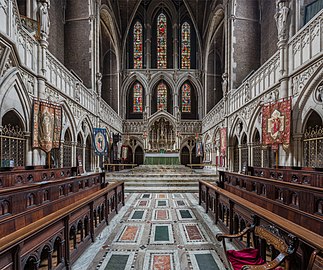St Augustine's, Kilburn
| St Augustine's, Kilburn | |
|---|---|
 | |
 | |
| Location | City of Westminster,London |
| Country | England |
| Denomination | Church of England |
| Churchmanship | Anglo-Catholic |
| History | |
| Founder(s) | Richard Carr Kirkpatrick |
| Dedicated | 1880 |
| Architecture | |
| Architect(s) | John Loughborough Pearson |
| Years built | 1871–1897 |
| Administration | |
| Diocese | London |
| Clergy | |
| Bishop(s) | Bishop of Fulham(AEO) |
| Vicar(s) | Colin J. Amos |
| Archdeacon | Archdeacon of Charing Cross |
Saint Augustine's, Kilburn,is aChurch of Englandchurch in the area ofKilburn,[1]in North London, England. Because of its large size and ornate architecture, it is sometimes affectionately referred to as "the Cathedral of North London",[2]although the church is not a cathedral in any official sense.
History
[edit]St Augustine's was founded by Richard Carr Kirkpatrick in theAnglo-Catholictradition in 1870. By 1871, a foundation stone had been laid and the original "iron church" was subsequently replaced by a much more ambitious building, aGothic Revivalchurch designed byJohn Loughborough Pearson.It is listed as a Grade I building byHistoric England.[3]
Architecture
[edit]Pearson's plans called for a red brick structure, vaulted ceilings, and extensive interior stone sculpture in a style reminiscent of 13th-centuryGothic architecture.The church was consecrated in 1880, but thetowerandspire,remarkable for such structures in the Victorian era, were not constructed until 1897–1898.[4]SirGiles Gilbert Scottdesigned thereredos(altar screens) for thehigh altarin 1930. He also designed the reredos of theLady Chapeland theStations of the Cross.In 1878, two years prior to the dedication of the church, contemporary historian Edward Walford had already referred to St Augustine's, Kilburn, as "one of the finest examples ofecclesiastical structuresin London. "[5]
The spire measures more than 77 metres (253 feet) high. Completed in 1878, thenavemeasures nine metres (28 feet) wide with nine bays and acrossingthat is bounded bytranseptson the north and south sides. Thereligious artin various forms depicts most of the major biblical stories.Clayton and Bellcreated thestained glass windows,which include a largerose windowdepictingthe Creation,nineclerestorywindows (five depicting types of angels), nave windows depicting saints connected with England, a window depictingSaint Augustineand several other talllancet windows.Paintings around the nave depict the healing ministry of Christ. Thechancelandsanctuaryare surrounded by densely-carved sculptural forms representing thePassion,Crucifixion,Entombment,andResurrectionof Christ, as well as theApostles,saintsand other religiousiconography.The south transept leads toSt Michael's Chapel with depictions of theEucharist,sacrifice,angelsand theworshipofHeaven.The Lady Chapel presents frescoes of the Christ child and a later carving of Christ'sPresentation in the Temple.[6]
-
The nave (looking east)
-
The rood screen
-
The nave (looking west)
-
The sanctuary
Today
[edit]The church stands prominently to the south ofKilburnand the north ofMaida Vale.It has two schools, St Augustine's Primary School andSt Augustine's High School.
Congregational history
[edit]Richard Carr Kirkpatrick served as parish priest at Saint Augustine, Kilburn, from 1870 to 1907. He formed the church after his parish at St Mary's, Kilburn, where he served ascurate,received an evangelical vicar unsympathetic to the Anglo-Catholic movement (also referred to as theOxford Movement,"Tractarians" or disparagingly as "Puseyites" after one of the founders of the movement,Edward Bouverie Pusey). Kirkpatick clothedEmily Ayckbowmas the founding sister of theCommunity of the Sisters of the Churchhere in 1870.[7]Kirkpatrick was followed in the vicarage by:
- Philip Leary, 1907–1930
- William Percy Theodore Atkinson, 1930–1954
- Harold Riley, 1955–1975
- Claude Eric Hampson, 1975–1977
- Raymond John Avent, 1977–1987
- Paul Tudor Rivers, 1987–1994
- Anthony H. Yates, 1995–2011
- Colin J. Amos, 2012–present
In popular culture
[edit]The interior of St Augustine's Church was used in the filming ofYoung Sherlock Holmes(1985), for the church of the Reverend Duncan Nesbitt (played byDonald Eccles). In the scene, Nesbitt is hit by a poison dart, and begins hallucinating about one of the stained glass figures (a knight) coming alive and trying to kill him. This knight is noted for being the first fullyphotorealistic animatedcharacter in any feature film.[8][9]
Gallery
[edit]-
West rose window
-
Western arcade
-
The font
-
Pulpit
-
Statues on the Rood Screen
-
The Rood flanked by Saints Mary and John
-
Painting north-west,Christ among the Doctors
-
The sanctuary pavement
-
Throne in the sanctuary
-
Chapel of St Michael
-
Altar in the Lady Chapel
See also
[edit]References
[edit]- ^Although in the Kilburn area, the church is located just within the boundaries of theCity of Westminster–see map[permanent dead link]for exact location
- ^"History".www.staugustine.london.Archived fromthe originalon 22 October 2020.Retrieved9 July2023.
- ^"A Church Near You" website, Church of England, accessed 2 March 2008,http://www.acny.org.uk/venue.php?V=15756[permanent dead link].
- ^Humphrey, Stephen and James Morris, Churches and Cathedrals of London, New Holland Publishers (London), 2006.
- ^Edward Walford, Old and New London: Volume 5, British History website, accessed 2 March 2008,http://www.british-history.ac.uk/report.aspx?compid=45234
- ^Saint Augustine, Kilburn website, accessed 2 March. 2008,http://www.saint-augustine.org.uk/section/14Archived23 July 2008 at theWayback Machine.
- ^"Ayckbowm, Emily Harriet Elizabeth [known as Mother Emily] (1836–1900), Anglican nun".Oxford Dictionary of National Biography(online ed.). Oxford: Oxford University Press. 2004.doi:10.1093/ref:odnb/51385.Retrieved16 November2021.(Subscription orUK public library membershiprequired.)
- ^"Visual and Special Effects Film Milestones".www.filmsite.org.Retrieved19 February2019.
- ^"Section 14: CGI in the movies".26 January 2014. Archived fromthe originalon 26 January 2014.Retrieved19 February2019.
External links
[edit] Media related toSt Augustine's Kilburnat Wikimedia Commons
Media related toSt Augustine's Kilburnat Wikimedia Commons- Official parish website
- Churches completed in 1880
- 19th-century Church of England church buildings
- Grade I listed churches in the City of Westminster
- Church of England church buildings in the City of Westminster
- Gothic Revival church buildings in London
- Anglo-Catholic church buildings in the City of Westminster
- Diocese of London
- History of the Church of England
- J. L. Pearson buildings
- Kilburn, London
- Anglo-Catholic churches in England receiving AEO















